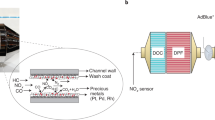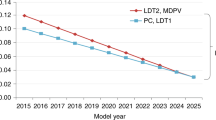With their high temperatures and brittle ceramic components, solid oxide fuel cells (SOFCs) might not seem the obvious fit for a power source for transportation applications. However, over recent years, advances in materials and cell design have begun to mitigate these issues, leading to the advantages of SOFCs such as fuel flexibility and high efficiency being exploited in vehicles. Here, we review these advances, look at the vehicles that SOFCs have already been used in, discuss the areas that need improvement for full commercial breakthrough and the ways in which catalysis can assist with these. In particular, we identify lifetime and degradation, fuel flexibility, efficiency and power density as key aspects for SOFCs’ improvement. Expertise from the catalysis landscape, ranging from surface science and computational materials design, to improvements in reforming catalysts and reformer design, are instrumental to this goal.
This is a preview of subscription content, access via your institution
Access options
Access Nature and 54 other Nature Portfolio journals
Get Nature+, our best-value online-access subscription
$29.99 / 30 days
cancel any time
Subscribe to this journal
Receive 12 digital issues and online access to articles
$119.00 per year
only $9.92 per issue
Buy this article
- Purchase on Springer Link
- Instant access to full article PDF
Prices may be subject to local taxes which are calculated during checkout




Similar content being viewed by others
References
IPCC Climate Change 2014: Mitigation of Climate Change (eds Edenhofer, O. et al.) (Cambridge Univ. Press, 2014).
Dagdougui, H., Sacile, R., Bersani, C. & Ouammi, A. in Hydrogen Infrastructure for Energy Applications (eds Hanane Dagdougui, Roberto Sacile, Chiara Bersani, & Ahmed Ouammi) 23–36 (Academic Press, 2018).
Leah, R. T. et al. Development of high efficiency steel cell technology for multiple applications. ECS Trans. 78, 2005–2014 (2017).
Yazdanie, M., Noembrini, F., Dossetto, L. & Boulouchos, K. A comparative analysis of well-to-wheel primary energy demand and greenhouse gas emissions for the operation of alternative and conventional vehicles in Switzerland, considering various energy carrier production pathways. J. Power Sources 249, 333–348 (2014).
Kim, H. C., Wallington, T. J., Arsenault, R., Bae, C., Ahn, S. & Lee, J. Cradle-to-gate emissions from a commercial electric vehicle Li-ion battery: a comparative analysis. Environ. Sci. Technol. 50, 7715–7722 (2016).
Staffell, I., Ingram, A. & Kendall, K. Energy and carbon payback times for solid oxide fuel cell based domestic CHP. Int. J. Hydrog. Energy 37, 2509–2523 (2012).
Jacobson, A. J. Materials for solid oxide fuel cells. Chem. Mater. 22, 660–674 (2010).
Medvedev, D. A., Lyagaeva, J. G., Gorbova, E. V., Demin, A. K. & Tsiakaras, P. Advanced materials for SOFC application: strategies for the development of highly conductive and stable solid oxide proton electrolytes. Prog. Mater. Sci. 75, 38–79 (2016).
Bianco, M., Linder, M., Larring, Y., Greco, F. & Van herle, J. in Solid Oxide Fuel Cell Lifetime and Reliability (eds Nigel P. Brandon, Enrique Ruiz-Trejo, & Paul Boldrin) 121–144 (Academic Press, 2017).
Boldrin, P., Ruiz-Trejo, E., Mermelstein, J., Bermúdez Menéndez, J. M., Ramı́rez Reina, T. & Brandon, N. P. Strategies for carbon and sulfur tolerant solid oxide fuel cell materials, incorporating lessons from heterogeneous catalysis. Chem. Rev. 116, 13633–13684 (2016).
Brett, D. J. L. et al. Concept and system design for a ZEBRA battery–intermediate temperature solid oxide fuel cell hybrid vehicle. J. Power Sources 157, 782–798 (2006).
Aguiar, P., Brett, D. J. L. & Brandon, N. P. Feasibility study and techno-economic analysis of an SOFC/battery hybrid system for vehicle applications. J. Power Sources 171, 186–197 (2007).
Brett, D. J. et al. Operational experience of an IT-SOFC / battery hybrid system for automotive applications. ECS Trans. 7, 113–122 (2007).
Barrett, S. (ed.) Delphi demos SOFC tech for truck APU. Fuel Cells Bull. 2010, 3 (2010).
Rechberger, J., Kaupert, A., Hagerskans, J. & Blum, L. Demonstration of the first European SOFC APU on a heavy-duty truck. Transp. Res. Proc. 14, 3676–3685 (2016).
Barrett, S. (ed.) Wärtsilä marine SOFC for Wallenius car-carrier. Fuel Cells Bull. 2010, 1 (2010).
Nehter, P., Wildrath, B., Bauschulte, A. & Leites, K. Diesel based SOFC demonstrator for maritime applications. ECS Trans. 78, 171–180 (2017).
Barrett, S. (ed.) Atrex, Ascend Energy demonstrate ATV with SOFC range-extender. Fuel Cells Bull. 2017, 3–4 (2017).
Barrett, S. (ed.) Ultra Electronics USSI wins SOFC contract for UAS platforms. Fuel Cells Bull. 2018, 6–7 (2018).
Leah, R. T. et al. Development progress on the Ceres power steel cell technology platform: further progress towards commercialization. ECS Trans. 78, 87–95 (2017).
Barrett, S. (ed.) Ceres, Weichai plan SOFC range-extender for China bus market. Fuel Cells Bull. 2018, 10 (2018).
Wood, T. & Ivey, D. G. in Solid Oxide Fuel Cell Lifetime and Reliability (eds Nigel P. Brandon, Enrique Ruiz-Trejo, & Paul Boldrin) 51–77 (Academic Press, 2017).
Bertei, A. et al. The fractal nature of the three-phase boundary: a heuristic approach to the degradation of nanostructured solid oxide fuel cell anodes. Nano Energy 38, 526–536 (2017).
Aphale, A., Liang, C., Hu, B. & Singh, P. in Solid Oxide Fuel Cell Lifetime and Reliability (eds Nigel P. Brandon, Enrique Ruiz-Trejo, & Paul Boldrin) 101–119 (Academic Press, 2017).
Chen, Y., Yang, L., Ren, F. & An, K. Visualizing the structural evolution of LSM/xYSZ composite cathodes for SOFC by in-situ neutron diffraction. Sci. Rep. 4, 5179 (2014).
Uhlenbruck, S., Moskalewicz, T., Jordan, N., Penkalla, H. J. & Buchkremer, H. P. Element interdiffusion at electrolyte–cathode interfaces in ceramic high-temperature fuel cells. Solid State Ion. 180, 418–423 (2009).
He, S. et al. A FIB-STEM study of strontium segregation and interface formation of directly assembled La0.6Sr0.4Co0.2Fe0.8O3-δ cathode on Y2O3-ZrO2 electrolyte of solid oxide fuel cells. J. Electrochem. Soc. 165, F417–F429 (2018).
Rinaldi, G. et al. Strontium migration at the GDC-YSZ interface of solid oxide cells in SOFC and SOEC modes. ECS Trans. 78, 3297–3307 (2017).
Morales, M. et al. Multi-scale analysis of the diffusion barrier layer of gadolinia-doped ceria in a solid oxide fuel cell operated in a stack for 3,000 h. J. Power Sources 344, 141–151 (2017).
Niania, M. et al. In situ study of strontium segregation in La0.6Sr0.4Co0.2Fe0.8O3−δ in ambient atmospheres using high-temperature environmental scanning electron microscopy. J. Mater. Chem. A 6, 14120–14135 (2018).
Rupp, G. M., Opitz, A. K., Nenning, A., Limbeck, A. & Fleig, J. Real-time impedance monitoring of oxygen reduction during surface modification of thin film cathodes. Nat. Mater. 16, 640 (2017).
Chen, Y. et al. Advances in cathode materials for solid oxide fuel cells: complex oxides without alkaline Earth metal elements. Adv. Energy Mater. 5, 1500537 (2015).
Yoshikawa, M., Yamamoto, T., Yasumoto, K. & Mugikura, Y. Degradation analysis of SOFC stack performance: investigation of cathode sulfur poisoning due to contamination in air. ECS Trans. 78, 2347–2354 (2017).
Wang, F. et al. Influence of water vapor on sulfur distribution within La0.6Sr0.4Co0.2Fe0.8O3 Cathode. ECS Trans. 50, 143–150 (2013).
Bozlaker, A. & Chellam, S. in Trace Materials in Air, Soil, and Water Vol. 1210 ACS Symposium Series Ch. 1 (American Chemical Society, 2015).
Takeguchi, T. et al. Study on steam reforming of CH4 and C2 hydrocarbons and carbon deposition on Ni-YSZ cermets. J. Power Sources 112, 588–595 (2002).
Ouyang, M., Boldrin, P. & Brandon, N. P. Methane pulse study on nickel impregnated gadolinium doped ceria. ECS Trans. 78, 1353–1366 (2017).
Wang, W. et al. Nickel-based anode with water storage capability to mitigate carbon deposition for direct ethanol solid oxide fuel cells. ChemSusChem 7, 1719–1728 (2014).
Duan, C. et al. Highly durable, coking and sulfur tolerant, fuel-flexible protonic ceramic fuel cells. Nature 557, 217–222 (2018).
Sengodan, S. et al. Layered oxygen-deficient double perovskite as an efficient and stable anode for direct hydrocarbon solid oxide fuel cells. Nat. Mater. 14, 205 (2014).
Du, Z. et al. Exceptionally high performance anode material based on lattice structure decorated double perovskite Sr2FeMo2/3Mg1/3O6−δ for solid oxide fuel cells. Adv. Energy Mater. 8, 1800062 (2018).
Boldrin, P., Millan-Agorio, M. & Brandon, N. P. Effect of sulfur- and tar-contaminated syngas on solid oxide fuel cell anode materials. Energ. Fuel. 29, 442–446 (2015).
Connor, P. A. et al. Tailoring SOFC electrode microstructures for improved performance. Adv. Energy Mater. 8, 1800120 (2018).
Boldrin, P. et al. Nanoparticle scaffolds for syngas-fed solid oxide fuel cells. J. Mater. Chem. A 3, 3011–3018 (2015).
Zhan, Z. & Barnett, S. A. An octane-fuelled solid oxide fuel cell. Science 308, 844–847 (2005).
Zhao, J., Xu, X., Li, M., Zhou, W., Liu, S. & Zhu, Z. Coking-resistant Ce0.8Ni0.2O2-δ internal reforming layer for direct methane solid oxide fuel cells. Electrochim. Acta 282, 402–408 (2018).
Chen, Y. et al. A robust fuel cell operated on nearly dry methane at 500 °C enabled by synergistic thermal catalysis and electrocatalysis. Nat. Energy 3, 1042–1050 (2018).
Sun, Y.-F. et al. An ingenious Ni/Ce co-doped titanate based perovskite as a coking-tolerant anode material for direct hydrocarbon solid oxide fuel cells. J. Mater. Chem. A 3, 22830–22838 (2015).
Neagu, D. et al. Nano-socketed nickel particles with enhanced coking resistance grown in situ by redox exsolution. Nat. Commun. 6, 8120 (2015).
Barrett, S. (ed.) FCO Power develops high power density, low-cost SOFC stack. Fuel Cells Bulletin 2013, 10, (2013).
Chen, Y. et al. A highly active, CO2-tolerant electrode for the oxygen reduction reaction. Energ. Environ. Sci. 11, 2458–2466 (2018).
Jacobs, R., Mayeshiba, T., Booske, J. & Morgan, D. Material discovery and design principles for stable, high activity perovskite cathodes for solid oxide fuel cells. Adv. Energ. Mater. 8, 1702708 (2018).
Dyer, M. S. et al. Computationally assisted identification of functional inorganic materials. Science 340, 847–852 (2013).
Choi, H. J. et al. Surface tuning of solid oxide fuel cell cathode by atomic layer deposition. Adv. Energ. Mater. 8, 1802506 (2018).
Develos-Bagarinao, K. et al. Multilayered LSC and GDC: An approach for designing cathode materials with superior oxygen exchange properties for solid oxide fuel cells. Nano Energy 52, 369–380 (2018).
Author information
Authors and Affiliations
Corresponding author
Additional information
Publisher’s note: Springer Nature remains neutral with regard to jurisdictional claims in published maps and institutional affiliations.
Rights and permissions
About this article
Cite this article
Boldrin, P., Brandon, N.P. Progress and outlook for solid oxide fuel cells for transportation applications. Nat Catal 2, 571–577 (2019). https://doi.org/10.1038/s41929-019-0310-y
Received:
Accepted:
Published:
Issue Date:
DOI: https://doi.org/10.1038/s41929-019-0310-y
This article is cited by
-
Space charge governs the kinetics of metal exsolution
Nature Materials (2024)
-
Proton Conduction and Electrochemical Performance of La/Pr co-Doped Ceria Electrolyte in Ceramic Fuel Cell
International Journal of Precision Engineering and Manufacturing-Green Technology (2024)
-
Gluing Ba0.5Sr0.5Co0.8Fe0.2O3−δ with Co3O4 as a cathode for proton-conducting solid oxide fuel cells
Science China Materials (2023)
-
Temperature Gradient Analyses of a Tubular Solid Oxide Fuel Cell Fueled by Methanol
Transactions of Tianjin University (2023)
-
Fabrication of Gd2O3-doped CeO2 thin films through DC reactive sputtering and their application in solid oxide fuel cells
International Journal of Minerals, Metallurgy and Materials (2023)



